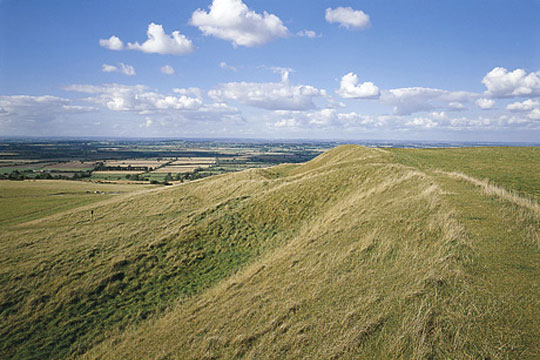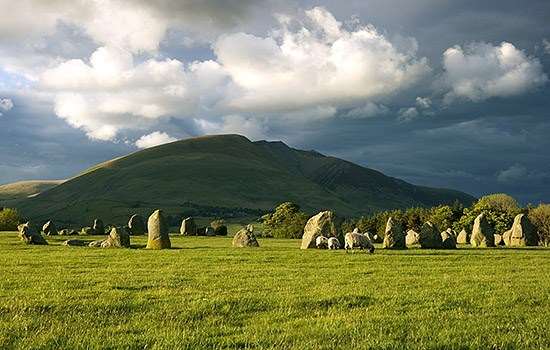History of Uffington Castle, White Horse and Dragon Hill
These three prehistoric sites are located beside the Ridgeway, the ancient route that stretched from Dorset to the Wash and that still traverses the chalk ridges of the Berkshire Downs.

Uffington Castle
The Iron Age hillfort known as Uffington Castle occupies the summit of Whitehorse Hill. It consists of a large enclosure, measuring about 220 metres by 160 metres, surrounded by a wide chalk-stone bank or inner rampart about 12 metres wide and 2.5 metres high, and formerly lined with sarsen (sandstone) stones.
Around this is a grass-covered ditch about 3 metres deep and a further, smaller bank forming an outer rampart. A causeway, flanked by the out-turned ends of the inner rampart, provides an entrance to the site from the west. This would have been closed by a gate.
Postholes and pits revealed during archaeological excavations serve as evidence of structures built within the enclosure during the hillfort’s occupation, while pottery and coins have been found in burial chambers close by.
The Iron Age buildings are likely to have been large round huts, each housing an extended family group. In the Middle Ages the land within the enclosure was ploughed and earthworks mark the ridge and furrow pattern of cultivation.
Large Iron Age hillforts are rare. Most are located on the high chalklands of the southern counties of England, and Uffington Castle is regarded as an outstanding example.
The White Horse
Situated 170 metres to the north-east of the hillfort – and visible from a distance of several miles – is the striking chalk-cut figure of a horse.
The White Horse, which measures 111 metres from the tip of its tail to its ear, has been dated to the later Bronze Age or Iron Age, between 1740 and 210 BC. It may have been a territorial marker or a fertility symbol – its function is not certain.
Once every seven years from at least 1677 until the late 18th century a midsummer ‘scouring festival’ was held, during which local people cleaned the chalk outline of the horse and enjoyed a celebratory feast within the hillfort.
The shape of the horse has changed over the centuries. The present outline may be only a part of the original: aerial photography shows that a larger, more conventional shape of a horse lies beneath. The loss of shape has been caused by slippage of the top soil and by repeated recutting. The head currently has a prominent ‘eye’, and tusk-like ‘beak’ at its mouth.
Dragon Hill
Local legend associates the horse with St George and the Dragon, hence the name of nearby Dragon Hill. This is a round mound, about 10 metres high with a flattened top, likely to have been formed by glacial erosion.
Further Reading
Miles, D, et al, Uffington White Horse and Its Landscape (Oxford, 2004)


